Link to Andrea Desrosiers' page on Tumblr
Contents
- Day 1 Pitch
- Day 2 Script
- Day 3 Trailer Take 2
- Day 4 Script
- Day 4 Storyboard
- Day 7 Script: Final Draft
-
Day 8 Shot List
- Rough Cut
- Final Project
- Science Out Loud
Day 1 Pitch
> Download from iTunes U (MP4 - 32.5MB)
> Download from Internet Archive (MP4 - 32.5MB)
This video is courtesy of Andrea Desrosiers on Tumblr and is provided under our Creative Commons license.
Day 2 Script: Draft of "What are My Braces Doing to Me?"
Cue music that is catchy and upbeat.
Zoom in on drawing of a young girl with braces on, looking a bit awkward.
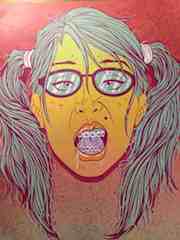
Cut to Andrea with same expression on face.
Andrea: Few things strike more dread than hearing you have to get braces! Whether it's worrying about how much it will hurt, what happens if a wire pops out, how you're going to talk, or how much your friends will make fun of you, it's kind of an awkward experience. So why even get braces…
Cut to pictures of famous stars who have had braces with voiceover.
Andrea: Studies have shown that having a beautiful smile with even, white teeth conveys health and youth, and makes people like you more.
Cut back to smiling Andrea…
Andrea: So what exactly is happening inside your mouth while the braces are on?
Cut to video of model teeth moving from crooked to straight.
Voiceover: The brackets and wires in your mouth are designed to push and pull on your teeth to get them into the right alignment. You can see this movement happening, often within the first couple of days after you get your braces on.
Cut to Andrea
Andrea: But while you can see the results just by looking in a mirror, what is happening inside your jaw is just as exciting. Your jawbone is literally being dissolved and reformed around your teeth. So how does that happen?
Cut to image of tooth bone structure.
Andrea: Each one of your teeth sits in a little pocket in your gums. Your gums cover your jawbone, which has a hole where this pocket sits. The roots of your tooth project into this hole to act like an anchor to secure your teeth in the jawbone. But your tooth doesn't actually come into direct contact with the jawbone - that would be painful every time you bit down to chew.
Cut to animation of biting down with tooth contacting bone, and "Ouch".
Cut back to image of tooth bone structure with periodontal ligament highlighted. Maybe have a tooth with a happy smile sitting on a cushion.
Voiceover: Instead the tooth under the gum line is surrounded by the periodontal ligament, which acts as a kind of cushion. The PDL as it's called allows your teeth to move around a little bit as you chew on things. So what happens when your braces need to move that tooth.
Animation: Tooth looks a little alarmed as a bracket is put on, and then says "whoa" when a lasso pulls it in one direction. The cushion is squeezed in one direction and stretched in the opposite direction.
Voiceover: As the tooth moves in its pocket, the PDL is squeezed in one direction and stretched in the other. This is what causes the pain you feel right after an adjustment.
Cut to Andrea, holding hand to jaw and looking unhappy.
Andrea: Your PDL's job is the keep your tooth cushioned. The part of the PDL that is being squeezed against the bone needs to create more space in your jaw, so it can feel comfortable again.
Cut to animation of tooth structure.
Voiceover: So what actually needs to happen is that a little part of your jaw needs to be dissolved so the PDL can feel like that nice fat cushion. The body contains cells called osteoclasts that come in and literally dissolve a little bit of the bone. This takes about 2–5 days. (maybe show animation)
Vioceover: But what happens to the part of the PDL cushion that got stretched?
Cut to animation of tooth structure with PDL stretching a looking like it may break.
Voiceover: Another kind of cell called an osteoblast comes in a builds up the jawbone, so the PDL cushion can get back into its proper shape. As the bone is built up, this is what holds your tooth in its new position. This process takes about 15–30 days.
Cut to Andrea walking around in an ortho office.
Andrea: Once that has happened, it's time to go back in for another adjustment, and starts the process all over again.
Andrea looks rueful.
Cut to image of entire body with skeleton highlighted.
Voiceover: Your jaw isn't the only place where these osteoclasts and osteoblasts alter your bone structure. In fact, this process is happening all the time as all of your bones grow.
Cut to Andrea walking around.
Andrea: (need closing statements…)
Day 3 - Andrea's Trailer Take 2
> Download from iTunes U (MP4 - 31.9MB)
> Download from Internet Archive (MP4 - 31.9MB)
This video is courtesy of Andrea Desrosiers on Tumblr and is provided under our Creative Commons license.
Day 4 - Andrea's Second Script Idea for Ortho
Andrea bites into an apple
Mmmm, delicious!
Eating foods is one of the great pleasures of life. And to enjoy foods like apples, carrots, or almonds, or even snack foods like a chocolate bar, or tortilla chips, we rely on one part of our bodies to repeatedly withstand as forces as high as 225 pounds: Our teeth. That's like having a mountain goat jump up and down on our teeth (sill - show).
Teeth are the hardest exposed substance in our bodies - even harder than our bones! On the Mohs scale, which rates minerals in terms of hardness, with talc at the low end and diamonds at the top, Human teeth rate 5 on a scale of 10. That's harder than iron or steel!
Each one of your teeth sits in a little pocket in your gums. Your gums cover your jawbone, which has a hole where this pocket sits. The roots of your tooth project into this hole to act like an anchor to secure your teeth in the jawbone. But your tooth doesn't actually come into direct contact with the jawbone - that would be painful every time you bit down to chew.
As you chew food, your teeth actually move a little bit, but why don't they actually fall out? It turns out they are anchored in the jawbone by a piece of specialized tissue called the periodontal ligament, or PDL. The PDL acts as a kind of cushion between the jawbone and the tooth. The PDL can easily absorb the normal forces that a tooth experiences when we chew, say, an apple.
Inside the PDL, there are all kinds of specialized types of cells. One type, called mechanoreceptors, sense forces of movement or pressure applied to the tooth. If the force is large enough, such as biting into a hard shell, these receptors tell your brain - hey stop biting down!
But sometimes, we need to apply large forces to the tooth to get them to move, like when you have braces. What does the PDL do then?
As the tooth moves in its pocket, the PDL is squeezed in one direction and stretched in the other. Your PDL's job is the keep your tooth cushioned. The part of the PDL that is being squeezed against the bone needs to create more space in your jaw, so it can feel comfortable again.
So what actually needs to happen is that a little part of your jaw needs to be dissolved away so the PDL can feel like that nice fat cushion. The body contains cells called osteoclasts that come in and literally dissolve a little bit of the bone. This takes about 2–5 days.
But what happens to the part of the PDL cushion that got stretched?
Another kind of cell called an osteoblast comes in a builds up the jawbone, so the PDL cushion can get back into its proper shape. As the bone is built up, this is what holds your tooth in its new position. This process takes about 15–30 days.
Once that has happened, it's time to go back in for another adjustment, and starts the process all over again.
Cut to image of entire body with skeleton highlighted.
Voiceover: Your jaw isn't the only place where these osteoclasts and osteoblasts alter your bone structure. In fact, this process of bony remodeling is happening throughout your body.
Engineers from MIT are taking advantage of the properties of osteoblasts to come up with a new compound that is composed of layers of materials that help promote rapid bone growth and will allow the body's own cells to produce bone that fixes the implant in place. (need to rework this) (Engineered Coating for Implants Reduces the Risk of Complications.)
Day 4 Storyboard
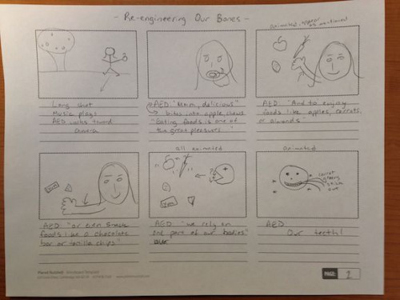
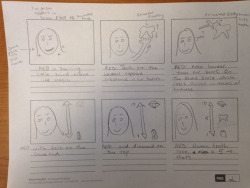
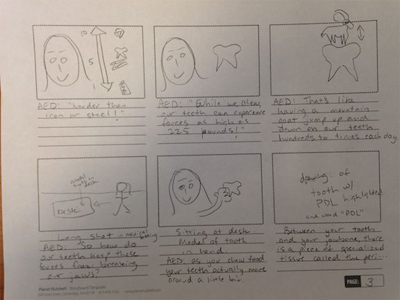
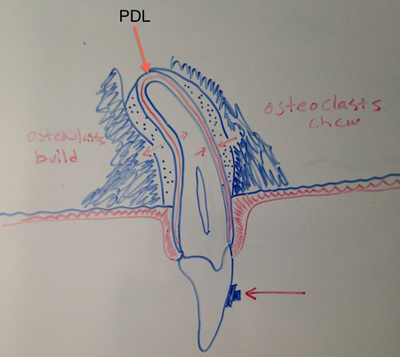
Script: Final Draft
Script for Ortho Video v4
(Long shot of Andrea walking around farmer's market) Eating foods is one of the great pleasures of life. And to enjoy foods from
(Panning shot of energy bar aisle at Harvest) VO: energy bars
(Panning shot of Flour bakery display.) VO: to cookies,
(Panning shot of Andrea walking in produce aisle.) to fruits and vegetables, we rely on one part of our bodies:
(Andrea picks up and apple from produce aisle.) "our teeth." (Close up on Andrea eating up an apple in quick video)
(Andrea filmed indoors, medium shot, holding a model tooth in hand.) Teeth are the hardest substance in our bodies - harder than our bones, and even harder than iron or steel!
(Andrea lifts tooth to shoulder height.) While we chew, our teeth actually experience forces up to 225 pounds - that's like having a
(Drawing of mountain goat appears above tooth.) mountain goat
jump up and down on our teeth hundreds of times each day…
(Animate mountain goat jumping up and down 3 times.)
(Cut to closeup of Andrea.)
so why doesn't our jaw just crumble under all those forces? (Drawing overlay outlining Andrea's jaw all cracked and jagged.)
(Show drawing) VO: Between your tooth and your jawbone, there is a specialized piece of tissue called the periodontal ligament, or PDL for short. The PDL can easily absorb the normal forces that a tooth experiences when we chew, say, an apple, cushioning or protecting our jawbone from our teeth.
(Show b-roll of cells maybe) VO: And inside the PDL, there are all kinds of cells. One type, called mechanoreceptors, sense forces of movement or pressure applied to the tooth. If the force is large enough, such as biting into an apple seed, these receptors tell your brain to stop biting down!
(Display model of perfect teeth.) Teeth sound like they're perfectly designed already…
(Closeup of Andrea with bubba teeth.) VO: But sometimes we really Need to force them in a certain direction… like with braces. (Cut to Andrea smiling with braces in.)
(Cut to drawing.) VO: As the braces slowly force the teeth to move, the PDL is squeezed in one direction and stretched in the other, like a rubber band.
Here's where it gets interesting - to make room, the mechanoreceptors in the PDL trigger cells called osteoclasts to come in and dissolve a little bit of the jawbone.
(Cut to drawing) VO: The mechanoreceptors also trigger another kind of cell called an osteoblast, which builds the jawbone back up, so the PDL cushion can get back into its proper shape, holding the tooth in its new position.
So if braces use osteoblasts to physically Reposition teeth for cosmetic reasons, what if we try to use them to Replace things to our bodies.
Dental implants replace teeth that are damaged or missing - to restore chewing function. And MIT engineers are using the properties of osteoblasts and osteoclasts that are already in our bodies to create a chemical coating for these implants. Just like in a mouth with braces, this coating helps create natural bone to help lock the implant in place.
Cut to image of entire body with skeleton highlighted.
Voiceover: Your jaw isn't the only place where these osteoclasts and osteoblasts alter your bone structure. In fact, this bony remodeling process is happening throughout your body.
So what if we replace things Inside our bodies, combining natural cells and tissues with synthetic parts, like a cyborg!
Sound like something out of science fiction? Well, it's already happening. And these synthetic implants aren't just limited to teeth—doctors can replace knees, hips, even spinal discs.
Right now, these implants are designed to have the same functionality as the body parts they are replacing. But in the future, scientists could make implants that work better than the original body parts.
Then we could become true cyborg - with implanted parts that fuse with the natural parts of our bodies to make us faster, stronger.
Smarter.
And once we've tasted the forbidden fruit will we still be human?
Day 8 Shot List
Ortho Shoot Scene 1
Locations:
Farmer's Market at Armory (Sat. 10:00 AM)
Harvest Coop (Thu. 9:00 AM)
Flour Bakery in Central (Thu. 1:00 PM)
Classroom blackboard (Wed. 3:00 PM)
Scene 1
Dialog:
Eating foods is one of the great pleasures of life. And to enjoy foods from… energy bars… to cookies… to fruits and vegetables, we rely on one part of our bodies: our teeth. Don't forget 10 sec of roomtone.
To Shoot:
Farmer's market (alternate: Harvest Coop)
- Andrea walking around produce aisle saying dialog. At end, pick up an apple when she says "fruits and vegetables."
Harvest Coop:
- Pan of energy bar shelves—about 10 seconds total.
Flour Bakery:
- Pan of cookies in bakery cases—about 10 seconds.
Classroom Blackboard:
- Closeup shot of Andrea eating an apple. Will be sped up in post. Do this once on each day. (Wed, Thu, Fri)
- Should probably have music.
Wardrobe:
- Red MIT sweatshirt, brown pants, hair in barette.
Props:
- Apple
—————————————————
Ortho Shoot Scene 2
Locations:
Classroom blackboard (mid-day)
Scene 2 Dialog
Teeth are the hardest substance in our bodies—harder than our bones, and even harder than iron or steel!
While we chew, our teeth actually experience forces up to 225 pounds - that's like having a mountain goat jump up and down on our teeth hundreds of times each day…
so why doesn't our jaw just crumble under all those forces?
To Shoot:
Classroom Blackboard
- Andrea delivering first 2 lines with glass tooth sculpture in hand. Leave room for goat to be displayed jumping in animation on top of tooth.
- Closeup of Andrea delivering 3rd line without tooth visible.
Wardrobe:
- Red MIT sweatshirt, brown pants, hair in barrette.
Props:
- Glass tooth, pedestal
————-
Ortho Shoot Scene 3
Locations:
Classroom blackboard (mid-day)
Scene 2 Dialog
Teeth are the hardest substance in our bodies – harder than our bones, and even harder than iron or steel!
While we chew, our teeth actually experience forces up to 225 pounds - that's like having a mountain goat jump up and down on our teeth hundreds of times each day…
so why doesn't our jaw just crumble under all those forces?
VO:
Between your tooth and your jawbone, there is a specialized piece of tissue called the periodontal ligament, or PDL for short. The PDL can easily absorb the normal forces that a tooth experiences when we chew, say, an apple, cushioning or protecting our jawbone from our teeth.
And inside the PDL, there are all kinds of cells. One type, called mechanoreceptors, sense forces of movement or pressure applied to the tooth. If the force is large enough, such as biting into an apple seed, these receptors tell your brain to stop biting down!
To Shoot:
Classroom Blackboard
- Andrea doing voiceover
- 5 second Closeup of Andrea biting down hard and making a pained face (to be displayed during line" such as biting into an apple seed, these receptors tell your brain to stop biting down!")
Wardrobe:
- Red MIT sweatshirt, brown pants, hair in barette
——————————-
Ortho Shoot Scene 4
Locations:
Orthodontic operatory (mid-day)
Classroom blackboard (mid-day)
Scene 4 Dialog
But what if we *want* to force teeth in a certain direction… VO: like with braces?
As the braces pull on the tooth, the PDL is squeezed in one direction and stretched in the other, like a rubber band.
Here's where it gets interesting - to make room, the mechanoreceptors in the PDL trigger cells called osteoclasts to come in and dissolve a little bit of the jawbone.
The mechanoreceptors also trigger another kind of cell called an osteoblast, which builds the jawbone back up, so the PDL cushion can get back into its proper shape, holding the tooth in its new position.
To Shoot:
Classroom Blackboard
- Close - up of Andrea delivering "here's where it gets interesting"
Orthodontic Operatory
- Andrea (in MIT shirt) stands in front of dental chair wearing goofy teeth to deliver line "But sometimes we Need to force teeth in a certain direction."
- Andrea hops in dental chair (will be sped up in post).
- Closeup of Andrea, dressed as doctor, pulling on gloves.
- Andrea hops out of dental chair and faces camera, smiling with fake braces in while VO says "like with braces"
Wardrobe:
- Red MIT sweatshirt, brown pants, hair in barrette, goofy teeth, fake braces
- Doctor gown, mask, gloves
Props:
- Dental chair
——————
Ortho Shoot Scene 5
Locations:
- Orthodontic Operatory
- Classroom Blackboard
VO
Your jaw isn't the only place where these osteoclasts and osteoblasts alter your bone structure. In fact, this bony remodeling process is happening throughout your body.
Where braces use bone remodeling to make teeth straighter for mostly cosmetic reasons, dental implants replace teeth that are damaged or missing - to restore chewing function.
Rough Cut
> Download from iTunes U (MP4 - 14.1MB)
> Download from Internet Archive (MP4 - 14.1MB)
This video is courtesy of Andrea Desrosiers on YouTube and is provided under our Creative Commons license.
Final Project
> Download from iTunes U (MP4 - 7.5MB)
> Download from Internet Archive (MP4 - 7.5MB)
This video is courtesy of Andrea Desrosiers on YouTube and is provided under our Creative Commons license.
CyberMouth
Creative Commons: CC BY-NC-SA, MIT
Hosted By: Andrea Desrosiers
Written By: Andrea Desrosiers
Additional Scripting: Elizabeth Choe, George Zaidan, Jaime Goldstein, Ceri Riley, George Zaidan, students of IAP15 20.219
Executive Producer: Elizabeth Choe
Director: Andrea Desrosiers
Editors: Andrea Desrosiers, Yuliya Klochan, Nathan Hernandez, Ceri Riley, Elizabeth Choe
Production Assistants: Nathan Hernandez, Fred Yarm
See the full credits on the course Tumblr.
Thanks to: Everyone in IAP15 20.219, the folks at DPI, and especially to my brother John Desrosiers, who inspired my love of science.
Science Out Loud
Andrea's video was professionally produced by Science Out Loud after this course finished.
> Download from iTunes U (MP4 - 11.3MB)
> Download from Internet Archive (MP4 - 11.3MB)
This video is from MITK12Videos on YouTube and is provided under their Creative Commons license.
